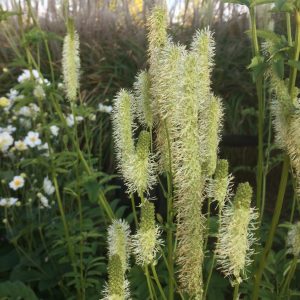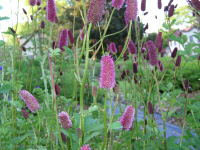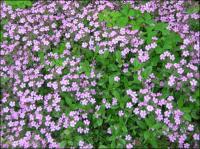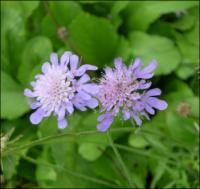Our Plants
Showing 489–496 of 587 results
-
Sanguisorba canadensis Canada burnet, Caribon feed, Indian tobacco, Marsh lily, Greater burnet Z 3-8
White spikes August – October when little else blooms in shady places
OUT OF STOCK
White spikes August – October when little else blooms in shady places
Size: 3-5’ x 3’
Care: part shade to sun in moist well drained soil
Native: Newfoundland, Labrador to Georgia W to Alaska, Wisconsin native.Sanguisorba is Latin meaning to soak up blood, for the plant’s reputed ability to clot blood. Collected in Canada in 1633. Collected in the U.S. by French plant hunter André Michaux.(1746-1802) Grown at America’s 1st botanic garden, Elgin Botanic Garden 1811.
-
Sanguisorba hakusanensis Korean burnet, Lilac squirrel Z 4 – 9
In mid to late summer bushy purplish-pink tails (like a Barbie doll squirrel tail) nod gracefully downward atop erect stems emerged from a clumping base that sprouts sage-colored, scalloped leaves.
OUT OF STOCK
In mid to late summer bushy purplish-pink tails (like a Barbie doll squirrel tail) nod gracefully downward atop erect stems emerged from a clumping base that sprouts sage-colored, scalloped leaves.
Size: 12-18”x12”
Care: sun to part shade in moist to moist well-drained soil
Native: Korea and JapanSanguisorba is Latin meaning to soak up blood, for the plant’s reputed ability to clot blood. Hakusanensis means coming from Haku, a mountain in Japan where this grows. Described in Botanical Magazine (Tokyo) in 1907.
-
Sanguisorba menziesii Menzies’ burnet Z 4-8
Claret wands of bottle-brush-shaped blooms atop nearly leafless 4’ tall stems in summer
Claret wands of bottle-brush-shaped blooms atop nearly leafless 4’ tall stems in summer
Size: 4' x 2'
Care: full sun to part shade in moist well-drained soil
Native: Alaska, Canada, Pacific NW
Awards: Royal Horticultural Society Award of Garden MeritSanguisorba is Latin meaning to soak up blood, for the plant’s reputed ability to clot blood. This species named for its collector Archibald Menzies (1754-1842), English physician and botanist. He found this in the Pacific NW while on Vancouver’s voyage in 1792 sailing to the Pacific Northwest, California, Alaska & Hawaii.
-
Sanguisorba obtusa Japanese burnet Z 4-9
A confection - neon Barbie-doll pink dangling bottle-brush spikes- in July - August
OUT OF STOCK
A confection – neon Barbie-doll pink dangling bottle-brush spikes- in July – August
Size: 2-3’ x 2’
Care: moist to moist well-drained soil in sun
Native: Honschu Japan
Wildlife Value: attracts bees and butterflies, Deer resistantSanguisorba is Latin meaning “to soak up blood”, for the plant’s reputed ability to clot blood. This species collected before 1873.
-
Sanguisorba parviflora syn S tenuifolia var. parviflora, S. tenuifolia var. alba White Japanese burnet Z 4-8
Drooping white spikes (I know, drooping and spike are an oxymoron but you get the idea) atop tall stems and above narrow, dissected foliage as beautiful as the flowers. Blooming in July into September.
Drooping white spikes (I know, drooping and spike are an oxymoron but you get the idea) atop tall stems and above narrow, dissected foliage as beautiful as the flowers. Blooming in July into September.
Size: 3-5' x 18"
Care: Sun to part shade in moist well-drained soil
Native: Japan, Korea, Russia
Wildlife Value: attracts bees and butterflies, Deer resistant.Collected by 1874. (Maxim.)
-
Santolina chamaecyparissus Lavender cotton , Cotton lavender Z 5-9
Grown for its ornamental grey foliage, yellow flowers in midsummer
Grown for its ornamental grey foliage, yellow flowers in midsummer
Size: 20” x 36”
Care: Full sun in well drained soil
Native: Mediterranean area
Awards: Recipient of the Royal Horticulture Society Award of MeritChamaecyparissus means dwarf cypruss to describe its appearance. Shrub grown in English and Italian flower gardens since 1500’s. Italians planted it with other shrubs to form mixed hedges. Grown in American colonial gardens since 1670’s.
-
Saponaria ocymoides Rock soapwort Z 4-9
Small bright pink flowers bloom along dense, creeping branches hugging the ground in late spring into summer.
OUT OF STOCK
Small bright pink flowers bloom along dense, creeping branches hugging the ground in late spring into summer.
Size: 3" x 18"
Care: Sun, well-drained soil
Native: Spain to Yugoslavia
Awards: Received England’s Royal Horticultural Society Award of Merit.Both the botanical and common names come from the plant’s use as soap, the leaves “yeelde out of themselves a certain iuice when they are bruised, which scoureth almost as well as sope.” Gerard (1633). Soapwort is still used today by antique and art restorers for its gentle cleaning: chop dried leaves and roots, boil in water for 5 minutes, and then agitate to make suds. William Robinson, father of today’s mixed perennial border gardens, praised this as bearing “masses of rosy blooms.”
-
Scabiosa lucida Pincushion flower Z 4-9
Lilac pincushions all summer & fall
OUT OF STOCK
Lilac pincushions all summer & fall, non-stop
Size: 24" x 12"
Care: full sun in well-drained soil.
Native: Central and Eastern Europe
Wildlife Value: attracts butterfliesScabiosa from Latin scabies referring to the itch caused by a mite infestation, which another Scabiosa species allegedly cured. This species 1st described in a French publication in 1779.






